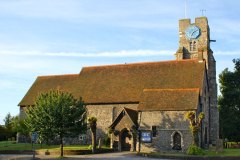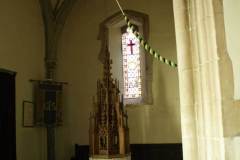St Dunstan’s Street
Introduction
This church is dedicated to St Dunstan, and is located at the western end of the street to which it gave its name. It was well known to most visitors to Canterbury, particularly the many pilgrims who would have made it their last stop before entering the city itself. However, it is perhaps most noted for its association with Sir Thomas More and Archbishop Thomas Becket at significant turning points in the relationship between church and state. Both were Chancellors of England, friends with a King Henry, martyred for their beliefs and canonised (Sir Thomas by the Roman Catholic Church much later in 1935!).
History
St Dunstan’s church was founded in the 10th century in the small settlement of St Dunstan’s without Westgate, on the main route to London and Whitstable. It was rededicated in 1030 to St Dunstan, Archbishop of Canterbury 959-988, who was canonised that year. He was the patron saint of goldsmiths and recognised for reviving monastic life in Britain, becoming England’s most popular Saint before Thomas Becket. Four years after the martyrdom of Archbishop Thomas Becket in 1070 Henry II came to Canterbury to give penance for his part in the murder of the Archbishop, entering the church to change into a woollen shirt before walking barefoot to the Cathedral.
The church had it’s roof raised and lancet windows added in the 13th century, the chantry chapel of the Holy Trinity to the north west added in the 14th century, a new south aisle and decorated windows in he 15th century and finally the brick Roper chantry and a perpendicular tower in the 16th century. In 1402 a licence was granted for a chantry at the altar of St. Nicholas on behalf of the influential and wealthy Roper family, who lived at Place House on the other side of St. Dunstan’s Street. This was replaced by the Roper Chantry, built in 1525 for William Roper. He was a Sheriff of Kent whose wife Margaret was the daughter of Sir Thomas More, Chancellor of England.
In 1535 Sir Thomas More was beheaded on orders of Henry VIII for refusing to sign the Act of Supremacy, but Margaret recovered the head from Tower of London and it was buried with her in the Roper vault in 1577. Later the vault was enlarged and the head transferred to a niche behind a grille in the wall where it remains to this day. There is a considerable amount of reading material in the chapel about these events. A porch was added in the late 17th century and the whole church renovated in the late 19th century to leave it much as seen today.
What to see:
- The Saxon north nave and chancel wall utilising herring bone flint work and long and short quoins externally (Image 1) with 13th century tie-beams and rafters internally (Image 3).
- The 15th century Roper chapel, one of the first buildings in Canterbury to be constructed of brick, with stone quoins and large depressed Tudor windows (Image 2). This accommodated the Roper family vault, altar tombs, and memorials (Image 4).
- The 1909 stained glass in the Roper chapel of St Dunstan, Sir Thomas More and Archbishop Lanfranc by local artist Mr. Caldwell, the Cathedral glazier (Image 5).
- The 1973 stained glass in Roper chapel depicting events in the life of Sir Thomas More (Image 6).
- A memorial slab to Sir Thomas More in the Roper chapel (Image 7).
- In the chancel a modern 1994 cross over the wooden altar and a 1933 art nouveau stained glass window by Aikman of the Transfiguration (Images 8 and 9). The blue curtain behind the altar conceals a late 19th century reredos now considered too ugly to be displayed!
- A 1984 stained glass depiction of the crucified Christ in the Roper chapel (Image 10).
- Just before the tower baptistry, an ancient chest with 15th century lid and ironwork and 19th century base, previously used to hold alms for the poor of the Parish.(Image 11).
- In the tower baptistry a 19th century stained glass window, the oldest in the church, of the infant St John (Image 12) and a plain octagonal 13th century stone font with a late 15th century cover restored following Puritan damage (Image 13).
- The 16th century perpendicular tower with clasping buttresses, an external round staircase and battlements containing an unusual two sided clock (Images 1 and 14).
Access: The church can be viewed externally at all times and is normally open during daylight hours.
Sources: Hogarth (2009)
SR














